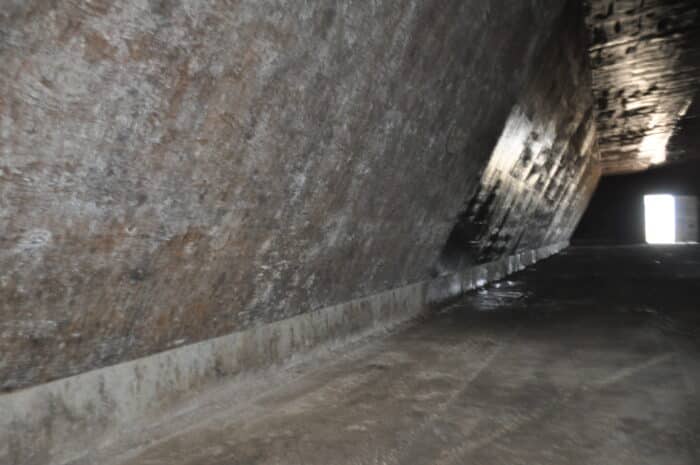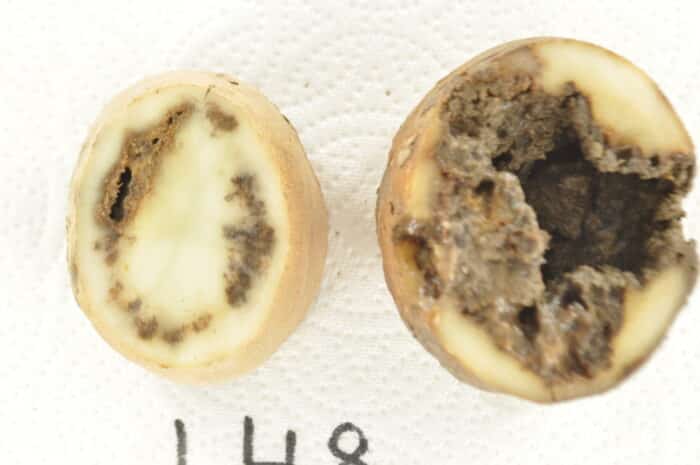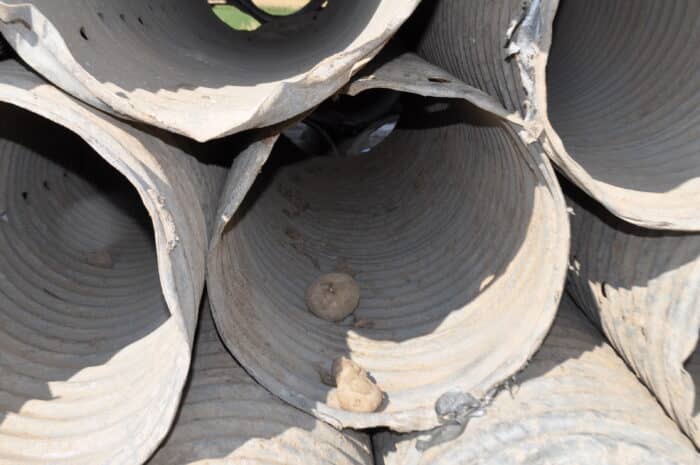Tips and tricks for cleaning and sanitizing your potato storages and equipment.
Experts


Editor’s note: This interview has been edited for length and clarity.
Spud Smart (SS): Why is cleaning and sanitation of potato equipment and storages important?
Nora Olsen (NO): Soilborne pathogens, nematodes, insects, and weed seeds can move from one isolated area or field and then spread to other fields on equipment. We want to make sure that we’re keeping pests where they originated. Having a cleaning program, whether it’s brushing off or power washing excessive soil in between fields, especially on harvesters where there’s a lot of soil associated with it, will really lower that risk of contamination from one field to the next.
The webinar will spend most of the time talking about cleaning storages and how important it is especially to minimize disease and foreign material carry over from one season to the next. Now, if there was a breakdown or hotspots from the previous year, there was a lot of that bacterial goo. And I know a pathologist like Gary Secor’s not going to want me to refer to it as goo. But not being a pathologist myself, we’re going to refer to that as either goo, or later I’ll talk about it being bacterial biofilms. Those remain as a source of inoculum for the incoming crop if you had an issue last year.

Gary Secor (GS): Potatoes get lots of diseases, the pathogens that cause these diseases — bacteria, fungi, nematodes, viruses — always accompany the potatoes. Because if the seed is infected, the pathogens remain in the seed. And they continue to remain in the seed during the cutting operation, or if you don’t cut in the whole seed, this is called vegetative propagation.
Most of the pathogens that affect potatoes cannot persist outside of a live potato, or do not spread in storage, or by equipment and handling of potatoes. These are not the sanitation targets, but some of the pathogens can.
SS: What potato diseases are possible if you don’t sanitize your storage correctly?
GS: The main targets, number one is bacterial ring rot… Ring rot is the number one pathogen for sanitation. The second important pathogen is silver scurf.
The bacterium that causes ring rot is the master of producing biofilms. It produces a bacterial slime that’s composed of polysaccharides — long chains of sugars that are great biofilms that protect these bacteria from adverse conditions, like heat and drying and freezing, and those conditions that would kill the bacteria, those biofilms protect them.
These bacteria produce a slime or biofilms, this enables them to survive on equipment and storage surfaces for one to three years. They can survive in the seed. They can survive on the equipment and storage surfaces. That’s why it’s so difficult to get rid of and why sanitation and disinfection is so important.

Silver surf is a seedborne disease caused by Helminthosporium solani… This fungus produces spores on stored potatoes after three to four months in storage…These spores are dislodged by air currents. When the air moves through the storage bin, or when potatoes are moved, those spores are released and infect other potatoes in storage, resulting in more silver scurf.
These spores can also move between storages that have a common air handling system. If you have silver scurf in one, you can move it to all the others as well. Now some of these dislodged spores remain in storage is from one season to the next. They can be the cause of silver scurf to newly harvested potatoes and storage due to the forced air distribution.
NO: Knock on plywood that hopefully you’re not dealing with any bacterial ring rot or BRR. But this cyclical disease can come back around every few years, and sanitation is the major way we have to deal with it. It can stay on hard surfaces for three years, and maybe even up to seven years depending upon what kind of surface you’re dealing with. So obviously, sanitation can be very important.
If you battle silver scurf, it can remain on various materials for up to nine months — maybe three months on plywood, nine months on foam insulation. If this is something that you’re dealing with, especially some of our thin skin varieties and in our fresh potatoes that we are worried about how they’re going to look, this is a key step to ensure that you can minimize your silver scurf infection by having a clean storage system.
SS: What are the steps for cleaning and sanitation?
NO: There’s four primary steps. The first step is to physically remove soil and debris. Second step is application of a soap-based detergent… Rinse with water if appropriate for the disinfectant and then you’re going to apply disinfectant — so really simple. There are companies out there that will do this for you that you can hire.
The first step is physically removing all dirt and debris. Now this could be done with shovels, brooms, pressurized water, but the key is to at least get the soil and debris off the surfaces. This is especially important with equipment. Many problems can be effectively eliminated by removing soil and debris.

The whole storage, not just the walls and things that are easy to see, the whole storage needs to be thoroughly cleaned. That’s including walls, beams, insulation, cement, dirt, floors, plenums, pipes, ventilation, humidification systems, you name it, anything that you can think of that comes in contact or could be part of the whole system needs to be cleaned.
After you have removed all the soil and have gotten all soil off of the surfaces, the next step is to wash the entire surface. Wash the entire facility and duct pipes with soap and pressurized warm or hot water. Soap-based detergents are particularly effective at dissolving dry potato sap, bacterial biofilms, or other residues that might be adhering to the floors, walls, or equipment. Now some pressure washers may not have the power to reach all areas, so a ladder or other means to ensure good coverage may be needed. But this is the most important step in the whole cleaning process — water with detergent. Thoroughly rinse all the clean surfaces before disinfecting because the disinfection will be less effective if the facility has not been cleaned and rinsed prior to application.
Next apply disinfectant solution to all the surfaces, that means all surfaces, walls, plenums, duct pipes. Assure it remains wet with the disinfectant solution for about 10 minutes…This length of exposure has been shown to effectively kill pathogens on equipment and in the storage facility. So very important to make sure that it lingers for that amount of time.
GS: It’s necessary to clean and sanitize all the equipment, like trucks and trailers, wooden seed boxes, machinery cutters and planters particularly, and storage surfaces. Basically, seed potato growers should do this annually.

They should sanitize anything that comes in contact with potatoes and pay special attention to the seed cutting rollers. Some of the older ones had open cell foams that allow moisture and bacteria to accumulate in the foam versus closed cell that does not allow the moisture to enter the foam. If you have ring rot, those bacteria get in the foam cells hidden in the foam and stay there until the next year when they get wet and then they start oozing bacteria again.
SS: What is important to keep in mind when applying disinfectant?
GS: What you should know is that most registered disinfectants work. If they’ve got an EPA or an FDA registration, they’re going to work because they’ve been tested against bacteria.
It’s important to follow the label recommendations. If it says dilute one to 10, don’t dilute one to five to make it stronger because it needs a one to 10 dilution to activate it properly. And the key to all this disinfection they have to be wet, the surfaces have to be wet for 10 minutes.
On metal surfaces it’s sometimes hard to keep that surface wet for 10 minutes. Adding a foaming agent to the disinfectant to hold it in place and keep it wet for 10 minutes.
NO: With disinfectant it’s important to check the disinfectant label to see if rinsing is required and be sure the product is labeled and registered in your state or province. Now, disinfection alone will not adequately clean a storage. There are many disinfectants out there, and some are more appropriate than others based upon the material you’re disinfecting.
In addition, some and disinfectants may need to be buffered before you apply them. So, it is important to read the labels and identify the appropriate disinfectant for what you need. Some are better on wood, and some may be better for bacterial ring rot. Decide what disinfectant you need based upon the type of material that you’re cleaning, as well as what your intended pathogen that you’re targeting.
Related Articles
How to Keep Potato Diseases out of Your Potato Storage
Guidelines to Manage Problem Potatoes in Storage
Updated Checklist for a Successful Harvest of the Storage Crop








